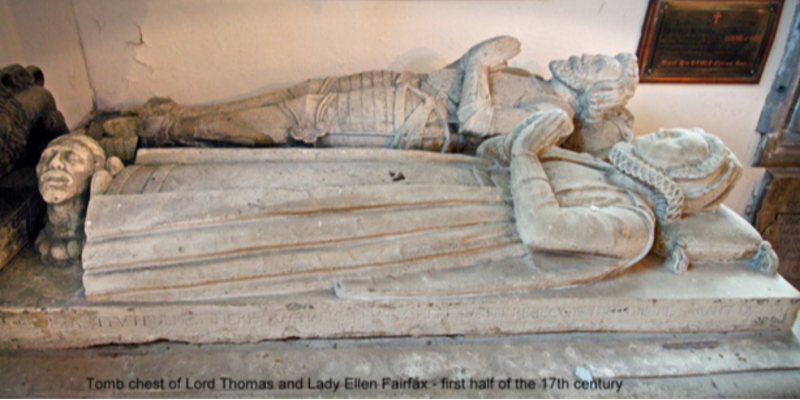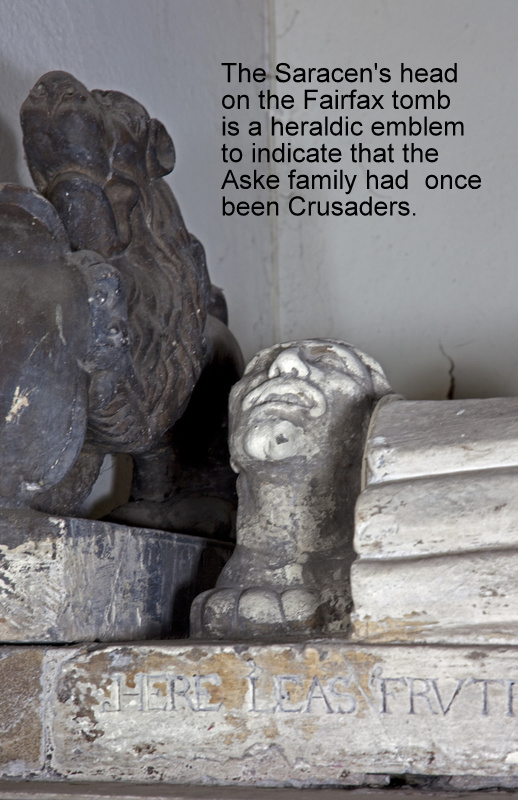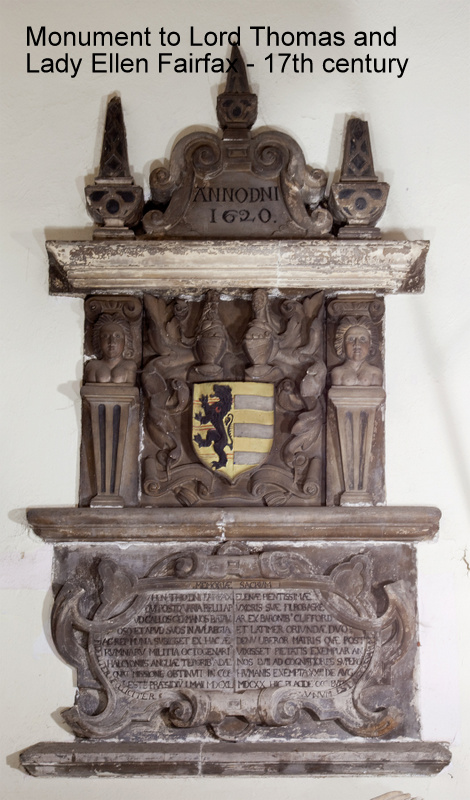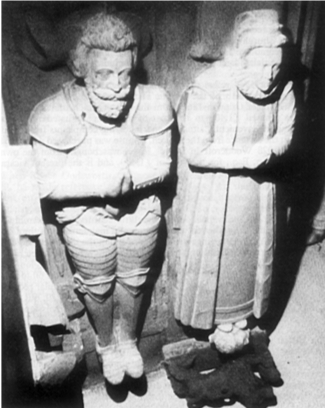The Fairfax Tomb
 By Allan Boddy
By Allan Boddy
THE TOMB of the First Lord Fairfax of Cameron and his wife Ellen dominates the south transept. The tomb is made of limestone from Hazelwood Quarry near Tadcaster which was owned at the time by a branch of another local family, the Vavasours. The tomb has been badly damaged as a result of subsidence on its south side which has led to the shearing off of the feet of the effigy of Lord Fairfax. One of the notable features of this monument is the Saracen’s head at the foot of Lady Fairfax and this is interpreted as showing that an ancestor of Lady Fairfax had been on the Crusades.
 Experts date the tomb as early 17th century but given that Lady Fairfax died in 1620 and Lord Fairfax died in 1640 it is interesting to speculate when exactly this monument to both of them was created. The two effigies were each carved out of single but separate slabs of stone and then cemented together and could have been put on the tomb at different times. The inscription below the effigy of Lady Fairfax – ‘Here Leah’s fruitfulness, here Rachaels’ beauty. Here lieth Rebecca’s faith, here Sarah’s duty’ – was written as a panegyric to Lady Fairfax by Lord Fairfax’s brother Edward but he died in 1635. This may suggest that the tomb was originally created for Lady Fairfax and that Lord Fairfax was added later but, as with so much connected with the early history of the Church building, there is no certainty.
Experts date the tomb as early 17th century but given that Lady Fairfax died in 1620 and Lord Fairfax died in 1640 it is interesting to speculate when exactly this monument to both of them was created. The two effigies were each carved out of single but separate slabs of stone and then cemented together and could have been put on the tomb at different times. The inscription below the effigy of Lady Fairfax – ‘Here Leah’s fruitfulness, here Rachaels’ beauty. Here lieth Rebecca’s faith, here Sarah’s duty’ – was written as a panegyric to Lady Fairfax by Lord Fairfax’s brother Edward but he died in 1635. This may suggest that the tomb was originally created for Lady Fairfax and that Lord Fairfax was added later but, as with so much connected with the early history of the Church building, there is no certainty.
Who were Lord and Lady Fairfax and why is their tomb in Otley Parish Church? The Fairfaxes have been described as one of the most prominent families in Yorkshire and they came to own Denton Hall in Wharfedale as a result of a rather lucrative marriage. In the early 16th century Denton Hall belonged to the Thwaites family and in 1518 Isabel Thwaites, who was heiress to the Denton estate, married Sir William Fairfax of Bolton Percy and Steeton. In 1557 their son, Thomas, duly inherited the estate and celebrated by building a magnificent Elizabethan mansion which sadly burnt down in 1734. He was succeeded by his son Thomas – our Thomas – in 1599. (Thomas was a favourite name for the Denton Fairfaxes!)
Our Thomas Fairfax was born at Bilborough in 1560 and married Ellen Aske in 1582. During his life he served as a soldier in the Low Countries; a diplomat on missions from Elizabeth I to James VI of Scotland; a Member of Parliament and a member of the Council of the North. He wrote books on horse breeding; household management and military matters which are now housed in the Brotherton Library. In 1627 he became the first Baron Fairfax of Cameron, a title in the peerage of Scotland. Wikipedia has the wry comment that the grant of the title by Charles I was ‘facilitated by a payment of £1,500.’ £1,500 in 1627 is probably equal to a quarter of a million pounds in today’s money – a lot of money to pay for a title which didn’t even get you a seat in the English House of Lords. According to the Otley Burial Register, when ‘the noble Thomas Lord Fairfax’ died in 1640 he ‘was buried with a great solemnity and company of Knights, Esquires, gents and yeomen of good rank and their attendants the first day of May in noble manner.’
 On the wall above the tomb there is another memorial to Thomas Lord Fairfax and his wife on which there are Latin inscriptions describing the two of them. It is said, rather lyrically, of Thomas ‘having ‘completed 80 years active service of tribulation in the halcyon times of England [he] obtained his discharge to the garrison of heaven.’ Ellen is equally lyrically described as ‘his devoted wife, daughter of Robert Aske Esquire, descended from the barons Clifford and Latimer, mother of twelve children who after she had lived for 57 years as a model of piety peacefully fell asleep here taken from her human to her heavenly relations on 23rd August 1620.’
On the wall above the tomb there is another memorial to Thomas Lord Fairfax and his wife on which there are Latin inscriptions describing the two of them. It is said, rather lyrically, of Thomas ‘having ‘completed 80 years active service of tribulation in the halcyon times of England [he] obtained his discharge to the garrison of heaven.’ Ellen is equally lyrically described as ‘his devoted wife, daughter of Robert Aske Esquire, descended from the barons Clifford and Latimer, mother of twelve children who after she had lived for 57 years as a model of piety peacefully fell asleep here taken from her human to her heavenly relations on 23rd August 1620.’
But why is the tomb of Lord Fairfax and his wife from Denton Hall in the south transept of Otley Parish Church? The answer is that the parish of Otley was much bigger in the early 17th century than it is today. The ancient ecclesiastical parish of Otley comprised the chapelries of Baildon, Bramhope, Burley in Wharfedale, Denton, and Farnley, and the townships of Esholt, Hawksworth, Lindley, Menston, Newall with Clifton, Pool-in-Wharfedale, and Little Timble. This is why we find memorials and dedications from families in places like Burley in Wharfedale and Baildon and the tombs of people living in Denton in Otley Parish Church.
Lord Fairfax of Cameron and his wife Ellen featured on the
stone tomb in the south transept of Otley Parish Church
 |
During the middle ages both the south and north transepts were private chapels. The chapel in the south transept was endowed by the family from Denton Hall and was known latterly as the Denton Choir. If you look around this transept you will see not only memorials to the first Lord Fairfax and his wife but also monuments commemorating the lives of his father, Thomas; his son, Charles; his niece Anne and his grandson, Charles.The Fairfax tomb is a grand monument even if the grandeur is now a little faded but is there anything in it? A member of the congregation confided in me that during an earlier restoration of the Church there was an opportunity to catch a glimpse of the inside of the tomb. What did you see there…? Nothing!